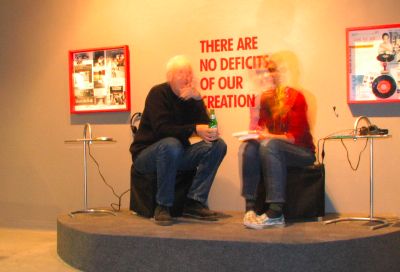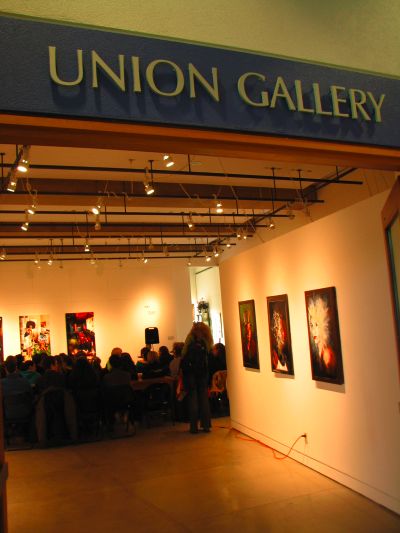 then + then again
then + then again
This past weekend I had the chance to travel to Kingston, Ontario... the infamous maverick & Canadian performance artist Clive Robertson was launching his Then + Then Again exhibition, a kind of archival retrospective of work dating back to the late '60s. Little did I know that Clive can sing like New Order & released vinyl as The Government with tracks like "Warfare versus Welfare," worked with Robert Filiou, John Oswald & Genesis P-Orridge, travelled with Fluxus, has made video, audio, film, built a recording studio, somehow became a professor at Queen's [here's his CV] & is an all around incredibly generous & talented individual -- and as usual, understated to his contributions. The whole thing took place at Modern Fuel artist-run centre & the Union Gallery at Queen's.

[Clive
Robertson being interviewed @ Modern
Fuel]
Clive, as one of the founders of the artist-run centre movement in Canada & Centrefold magazine (now FUSE, where I reside as a contributing editor), asked me to be on a panel for the whole shindig -- I obliged, not quite knowing what I was getting into. Above is the opening of the panel, the Artist's Oath read by equally impressive performance artist Johanna Householder (of the Clichettes), a piece by Clive (who appears as the camera pans left). The three of us attempted to reinterpret the totality of the relation between contemporary art & the artist-run centre movement in under two hours, with questions and interjections from Tanya Mars, Carol Conde & Karl Beveridge among others.

I must admit I opened with some provocation, denouncing Contemporary Art in Big Letters (or rather set forth the question: "When and how did Contemporary Art appropriate subversive collective practices?") -- or somesuch, less a statement in stone than an attempt to jumpstart discussion as the eager-beaver and guinea-pig (and relative unknown) of my betters. I also had a stab at what (unfortunately, in some cases, and with many caveats) the artist-run centre movement has become or appears to be becoming -- as in, something of a career-related employment opportunity rather than a collective organisation of hopes, an institution than a movement, a blockage than an accelerator, usually somewhat insular and closed, requiring all kinds of art-political manoeuvring to get involved. This statement, designed to provoke, and which I believe offput Tanya Mars a bit, should be better explained with some subtly. I will only attempt a rough sketch here, noting off the bat the immense contribution the artist-run centre movement has had to preserving and disseminating the arts in Canada, especially the lower-case contemporary arts, however one sees them. Artist-run centres, CARFAC, and the Canada Council are all of similar pressures by artists to establish art as part of the social fabric in Canadian society.
But today the entire trilogy requires some remixing. I view the artist-run centre movement under the terms of its own engagement, that is, from its own ideals. From this point-of-view, I see it as, by necessity, an open organisation run by artists for artists -- and with no prerequisite definitions as to what "art" might mean in this context save to address what is being made, here and now as well as then + then again. I see these organisations as flexible and adaptable to the changing nature of art, in its production, culture & context. With this in mind, I think some artist-run centres live up to their mission (probably those in smaller cities...) while others have become somewhat stale (and become bureaucratic gallery-style structures... probably in bigger cities -- to offer a geothesis).
Thus artist-run centres, when they "go out into the community" (such as *cough* working with community radio, for example) need to ensure to invite & open their space to (budding & outsider) artists who frankly lack the courage to simply step into the fray. Outreach, basically: invitations to involvement. Many movements have come & gone that have not been reflected in the artist-run centre structure which is nonetheless supposed to reflect artists as a group. So if I critique artist-run centres from this general principle, it is because the collection of centres themselves came about and exist under such principles, because such a principle is embodied in their very name, as their raison d'etre.
Another way to put it: in order for artist-run centres to survive and to retain their relevancy as a body existing parallel or outside of the gallery system (or, more and more today, in a complex hybrid space of negotiation), they need to ensure open access in a much more timely manner than 3-year grant application timelines for exhibition space. Quick-access space and resources are needed by artists everywhere. Many artist-run centres are in the lucky position of sitting on good property found some 30 years ago. Artists today have little chance of acquiring such resources. Artist-run centres need to set aside time & space for interventions, occupations & sudden events requiring space, for exhibitions of urgency & necessity that will happen regardless of a years-in-advance-Canada-Council grant. I hope & encourage & believe that such things should be touching on the artist-run centres, happening in them or through them or in communication with them at least -- otherwise generations will exist that only view the artist-run centre as an institution like any other; and when the time comes to defend them & renew them, few supporters will be found. Artist-run centres are a baby-boomer project, basically, and like all boomer institutions they are facing serious questions as to their futurity as well as coordinated attempts at undermining their existence through forces that should be fought -- i.e. the whole slash-and-burn neoconservative agenda of dismantling the welfare state. In this scenario, they need the support of the Now, the Recent and most importantly, the To-Come.
As I said on the panel, the dissolution of the welfare state appears inevitable, but it doesn't mean the artist-run centre must cease to exist when the Canada Council can no longer fund shoestrings -- it means that the "movement" should be tying into the global networks, in a word the "postnational" setting in which the alter-globalization of art takes place. The very inspiriation for artist-run centres in Fluxus is also found in this postnational context in the shared history of telecommunication arts. It is here in which many artists operate and in which they no longer communicate with artist-run centres -- but I believe that timechanges & speeds only *appear* too drastic between these two networks. Ironically, overcoming timelag is part of the history of artist-run centres themselves and was one of the reasons for their founding -- to present artist's work of the Now (to abstract & interpret a few comments of Clive's). Thus my proposal (and I guess, critique) is neither radical nor new; rather, it seeks to renew & to carry onward with what was jumpstarted back in those heady days of the '60s. Tying the artist-run centres into the "networks" would be a worthy goal say, by the apparently epic year of 2010 (the Vancouver Olympics, people, and the moment wherein we are *really* into the 21C for good).
I know that above I keep saying "artist-run centres *should* do X, Y or Z" -- this isn't to brand them faceless or to throw the evolutionary problematic in their lap. The point is to open them up so fresh energies can take on these very responsibilities in cooperation and collective action with, as Clive put it, the "mentors" (or however we wish to say it, taking Johanna's critique of the term into account: basically, bridging the generational gap which is all too much a problem in media-driven society, opening up the avenues between the ages, just as Fluxus did for Clive all those eons ago).
posted. Thu - January 18, 2007 @ 01:06 PM |
..ziP:
./them.hallucinates./.
.this blog sketches patterning / [tV] -- everything here is in-progress, often a mess of thoughts and poorly edited grammar.


past.projekts
.. @rchives //
XML/RSS feed.me //
numbers that mean little:
absolut numerosity..:
...puplished 0n: Jan 18, 2007 01:18 PM
...puplished 0n: Jan 18, 2007 01:18 PM